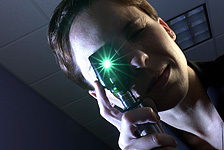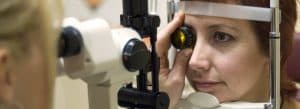If you’ve been diagnosed with diabetes, it’s essential that regular eye exams are part of your healthcare routine.
According to a report from the Centers for Disease Control and Prevention (CDC) entitled National Diabetes Statistics Report 2020: Estimates of Diabetes and Its Burden in The United States, around 32.4 million (10.5% of the population) people have diabetes.
Unfortunately, many people who suffer from diabetes will also develop vision-threatening conditions as a result.
This is why regular eye exams with your eye doctor are even more important if you’ve been diagnosed with diabetes.
So, what is diabetes, what makes it so dangerous for your eyes and how can your eye doctor help?
Defining diabetes
Diabetes is a disease in which the body is either not able to produce or properly utilize the hormone insulin to regulate the amount of sugar (or glucose) in your cells.
Diabetes can cause a number of negative effects on your body, including those that affect your eyes and vision.
There are two types of diabetes, type 1 and type 2.
Type 1 diabetes (T1D)
Type 1 diabetes is considered an autoimmune reaction that causes the body to be unable to produce insulin. This is a rarer form of diabetes, affecting 5%-10% of all diabetics having type 1.
T1D is usually found in children, teens and young adults, with symptoms developing relatively quickly. Those with type 1 diabetes will be required to take insulin every day. There are no known methods of prevention for type 1 diabetes.
Type 2 diabetes (T2D)
Type 2 diabetes is much more common than type 1, with 90%-95% of all diabetics having type 2.
This type of diabetes involves the body being unable to properly process insulin, leading to difficulties in regulating glucose levels in the blood. This type of diabetes develops over time, and is usually diagnosed in adults. Prevention includes eating healthy, exercising and maintaining a healthy weight.
According to a January 2004 article in Diabetes Care, a publication of the American Diabetes Association, nearly all patients with type 1 diabetes, and over 60% of those with type 2 developed a sight threatening disease known as diabetic retinopathy within the first 20 years of being diagnosed with diabetes.
Though diabetic retinopathy is the leading cause of vision loss in diabetics, there are several conditions linked to diabetes that can harm a person’s vision.
Listed below are eye conditions linked to diabetes:
Blurry vision
A complication of diabetes is bulging of the focusing lens in the eye in response to elevated blood sugar. This produces a blurring of vision that can be quite bothersome, but which is ultimately temporary.
If you notice your vision is blurry, don’t go out and buy new glasses right away, it could just be a short-term issue brought on by elevated blood glucose.
It’s possible that the high sugar levels have caused your focusing lens to bulge, causing short-term blurry vision.
Once your blood sugar has returned to the normal range, your lens returns to the usual shape and the clear vision returns. However, if the blood glucose level remains high the vision will remain blurry.
SEE RELATED:6 Ways Diabetes Affects Your Eyes
For more information on how diabetes can affect your eyes, and to discuss the best treatment options, contact your local eye doctor.
Diabetic retinopathy
This condition occurs after extended periods of high blood sugar cause the walls of the small blood vessels in the eye to weaken and begin to leak.
Once this happens, parts of the eye begin to have difficulty receiving enough blood. In order to compensate for this, the eye begins creating new blood vessels leading to those parts.
Unfortunately, the new blood vessels are also weak, and soon begin to leak as well. Over time, this can lead to scarring of the eye, retinal detachment and even total loss of vision.
In many cases, a person with diabetic retinopathy will not experience any symptoms until irreparable damage has already been done to their vision.
Diabetic maculopathy
Diabetes can also cause maculopathy, also known as macular degeneration. This condition affects the macula, an area of the retina which is dense in photoreceptors and is responsible for central and fine-detail vision.
Maculopathy is marked by a complete or partial loss of central vision, usually in both eyes.
Diabetic maculopathy can make routine activities such as reading, driving and recognizing the faces of loved ones difficult or impossible.
Fortunately, early detection of this condition increases the possibility that vision loss can be prevented. Your doctor may recommend certain eye surgeries and medications that can help.
Glaucoma
Over time, the extra blood vessels created by diabetic retinopathy can begin to cause an increase in the eye pressure inside the eye and lead to a condition known as glaucoma.
Glaucoma is a group of eye diseases that are characterized by damage to the optic nerve caused by elevated inner eye pressure.
Glaucoma can remain undetected until significant loss of vision, such as Tunnel Vision, has already occurred.
If it goes untreated, glaucoma can cause total blindness.
Routine diabetic eye exams will include screenings for glaucoma so that it can be caught as early as possible. The earlier the diagnosis, the more likely that your eye doctor can save your vision.
There is no cure for glaucoma, but it can be managed in most cases using specialty eye drops and medicines. In some cases, your eye doctor may recommend certain surgeries to treat your glaucoma, but this is rare.
Cataracts
Cataracts are a natural and common part of aging, with the National Eye Institute reporting that over 50% of all Americans will have had cataracts by age 80.
Cataracts occur when protein begins to build up in the eye. As it solidifies, it begins to cloud the eye. This results in glare and blurring of vision. Ultimately, a cataract can result in total vision loss in the affected eye if it goes untreated.
Fortunately, cataract removal surgery is quite common and is both effective and safe.
Though annual eye exams are important for everyone, those with diabetes should be extra cautious to make it to their eye doctor for a regularly scheduled exam. This will minimize the chances of vision loss as a result of undiagnosed eye problems brought on by diabetes.
LEARN MORE: Guide to Eye Conditions
If you have diabetes, scheduling an appointment with an eye doctor is essential for healthy eyes and clear vision.
Many people who suffer diabetes will also develop vision-threatening conditions as a result.
If you’ve been diagnosed with diabetes, it is essential to have regular eye exams with your eye doctor.








